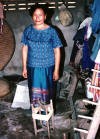SILK
Silk is an animal fiber, but rather than being animal fur, silk is the fiber from the cocoon of the silk worm moth. Spider webs are made of a similar type of fiber, and like silk, both are extremely fine and very strong. Like other moths, the silk worm moth has a four stage life cycle: egg, larva or caterpillar, pupa, and adult. The larva is a feeding stage. The pupal stage undergoes a metamorphosis from caterpillar to adult moth, and is protected within its silken cocoon. When the caterpillar has gained enough weight from eating mulberry leaves it weaves a silk cocoon. The silk fibers are held together by a gum secreted by the caterpillar.
To harvest the silk, the cocoon is soaked in hot water to loosen the gum and release the fibers. An individual silk fiber can be a quarter of a mile to nearly a mile long. Fibers from several cocoons are twisted into a fine silk thread. Several threads are twisted together to make a strand of silk yarn. It may take 2,500 to 3,000 cocoons to make one yard of fabric. Silk fabrics can vary from heavy to sheer, and they are famous for their ability to take vivid dyes.
These images were taken in Mahasarakan, Thailand, and they represent the willingness and kindness of the silk coop ladies to show their village industry to an interested visitor.
|
Silk Worm Moth Eggs |
Silk worms, caterpillars, feeding |
Mulberry leaves |
Pupation basket |
|
Silk worms spinning cocoons |
Fully spun cocoons |
Silken cocoons and silk thread |
Spinning silk yarn |
|
Thai silk weaver |
Mahasarakan silk coop |
Silk sari fabric |
Attractive silk sari |
These images are the copyright property of Prof. J. E. Armstrong. Any use of these images without permission is prohibited.
Email: jearmstr @ ilstu.edu











